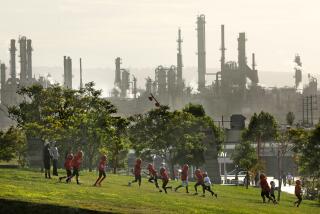Refinery Blast Sparks Warning on Possibility of Poisonous Gas Release
- Share via
Citing a November explosion at the Mobil Oil Corp. refinery in Torrance, South Coast Air Quality Management District officials have warned that the possibility exists for a “significant release” of hydrogen fluoride gas at facilities that use the chemical.
An AQMD staff report obtained Monday calls for creation of a “high-level, multiagency” task force that would consider phasing out use of the lethal hydrofluoric acid throughout the greater Los Angeles area.
Liquid hydrofluoric acid turns to hydrogen fluoride gas under temperature and pressure conditions found in refineries, if exposed to the air.
“While the likelihood of a major release is remote, the consequences may be so great as to warrant regulations to direct the industry to phase out its use or substitute processes with lesser environmental hazards,” the report says.
Other refineries use sulfuric acid, which is considered safer than hydrofluoric acid, in the refining process.
An excess of hydrofluoric acid in a refinery processing unit was responsible for a thunderous explosion that rocked the Torrance refinery Nov. 24, sparking a spectacular fire that burned for two days.
The blast, heard for miles, injured four people, shattered windows and caused millions of dollars in damage to the refinery that converts California crude oil to gasoline, diesel and jet fuel and other petroleum products.
The report said the fire caused a small emission of hydrogen fluoride gas that officials did not deem dangerous.
The AQMD report, signed by agency Executive Director James M. Lents, will be presented to the AQMD board Friday. It recommends that the board acknowledge the continuing “potential for a significant hydrogen fluoride release and the associated public health risk.”
A significant release caused by employee error, an earthquake, sabotage or some other scenario could pose an “extreme and immediate health hazard to exposed citizens,” the report says. Almost 500,000 residents live within five miles of the Mobil plant.
According to the AQMD report, other facilities in Los Angeles County that use or store hydrofluoric acid in significant quantities are Allied Corp. in El Segundo; Union Pacific Resource refinery, Wilmington; Jones Co., South Los Angeles; Powerine Co., Santa Fe Springs, and the Golden West Refining Co. refinery, Santa Fe Springs.
The report also presents data about the release of other chemical pollutants during the Mobil blaze. For example, the 41-hour fire released a quantity of carbon monoxide equivalent to that produced by the plant during 1986.
Mobil spokesman James Carbonetti said he could not comment on the report because he had not seen it. He said the proposed task force “certainly sounds like a good idea.”
The Environmental Policy Institute of Washington said last December that an accident involving hydrofluoric acid could pose as serious a danger as the 1984 disaster at the Union Carbide plant in Bhopal, India, which killed more than 2,000 people.
The environmental group said 58 U.S. oil refineries, including Mobil, Golden West and Union Pacific, use the chemical. It cited an incident last October in which a hydrofluoric acid leak at the Marathon Oil Co. refinery in Texas City, Tex., produced a toxic cloud that injured more than 60 people and forced 3,000 people from their homes.
‘Largely Overstated’
Responding to the institute report, refinery manager Wyman D. Robb said at the time that the environmental group “largely overstated” the risk involved in using hydrofluoric acid. Robb said Mobil had been using hydrofluoric acid in the refinery for 40 years to boost the octane of gasoline, and “we have never had a serious incident where the acid has been emitted into the community.”
“We have an awful lot of respect for it,” Robb said at the time. “We have designed and built our process units with the utmost of safety.”
On Monday, Environmental Policy Institute spokesman Fred Millar praised the AQMD recommendations. But he said Mobil should reconsider the location of the refinery.
No Specific List
“It is a very unfortunately located site,” he said, referring to the heavily populated area.
AQMD spokesman Tom Eichhorn said no specific list for the task force has been drawn up but said it would probably involve local fire departments and emergency response teams, as well as affected industries and regulatory agencies.
Torrance Mayor Katy Geissert said Monday that she had not seen the AQMD report but the use of hydrofluoric acid “certainly warrants very, very close monitoring and scrutiny.”
More to Read
Sign up for Essential California
The most important California stories and recommendations in your inbox every morning.
You may occasionally receive promotional content from the Los Angeles Times.










